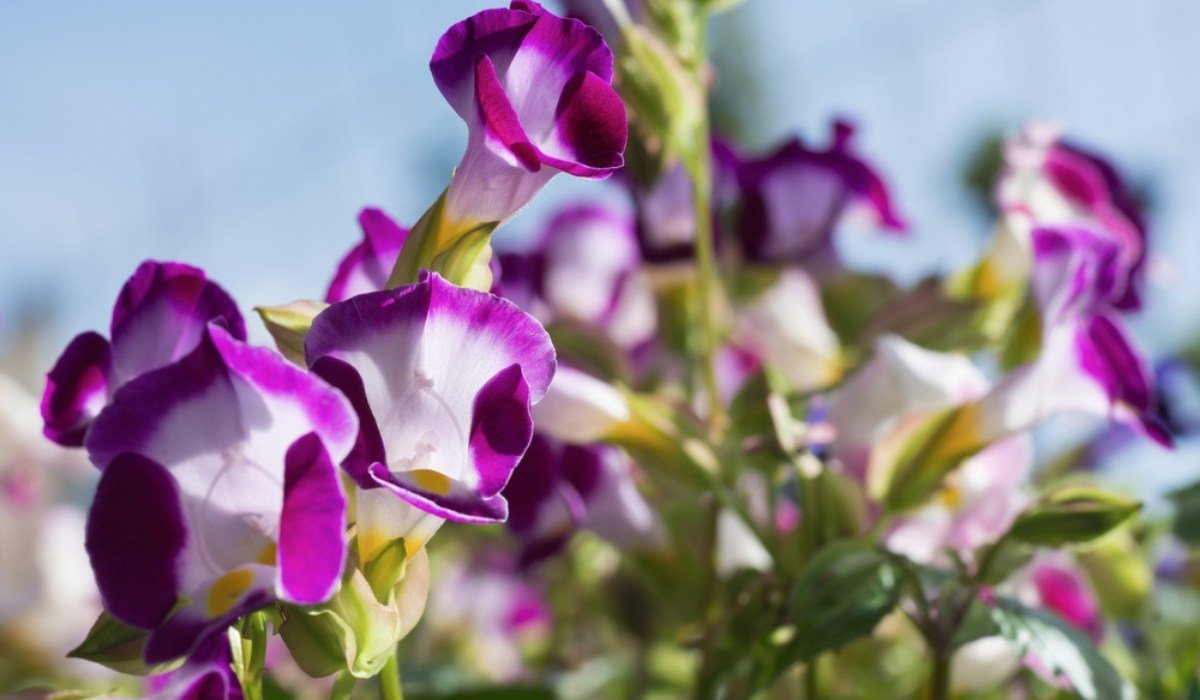The annual Linderniaceae plant Torenia Fournieri, often known as the bluewings or Wishbone Flower, has blue, white, or pink blooms with yellow markings. It usually grows as a landscape annual and gets 12 to 15 inches long. To add some colour and vitality to a more shady area of the garden, Wishbone Flowers are an excellent pick.
These small plants wouldn’t mind growing in partial shade, unlike many other annual flowers. The predominant species’ colour is dark blue-purple and lavender with yellow markings; however, its trumpet-shaped flowers are available in a variety of colours. The plant gets its popular name from the way that each flower’s stamens join together to form an arrangement that resembles a wishbone.

Source: Pinterest
Wishbone flower: Facts
| Botanical name | Torenia Fournieri |
| Type | A medium sized shrub |
| Leaf colour | The leaves are light purple and green |
| Flower | Yes |
| Also known as | Wishbone flower |
| Height | 3-4m tall |
| Season | Summer |
| Sun exposure | Keep in shade with a few hours of direct sunlight |
| Ideal temperature | 70 to 90 degrees Fahrenheit |
| Soil type | Well-drained |
| Soil pH | Slightly acidic to slightly alkaline |
| Basic requirements | Intermittent watering, indirect sunlight, home-made fertiliser |
| Ideal location for placement | Outdoors |
| Ideal season to grow | Mid summer |
| Maintenance | Low |
Wishbone flower: Types
- Catalina or White Linen: This variety grows to a height of around 16 inches and has all-white blooms with a golden throat.
- Kauai Rose: Flowers that are brilliant pink and white, are eight inches tall and broad, and stand out for their resistance to heat and humidity.
- Moon Purple: This variety, which reaches a height of approximately ten inches, has lavender and dark purple blossoms.
Wishbone flower: How to grow?
- Take stem cuttings that are at least 6 in. long to produce wishbone blossoms. At the stem’s base, try to create a node that will likely root.
- Place the cutting in water after removing any leaves from its lower half. Plant the cutting in a peat or paper pot with a good potting mix as roots start to appear, and make sure the soil is kept wet.
- Before placing the plant in your garden or an outdoor container, bring it outside for progressively longer periods of time over the course of roughly a week to acclimatise it to the outdoors.
Wishbone flower: Care tips
There isn’t much upkeep required other than making sure your plants have enough water and food. While not necessary, deadheading (removing wasted flowers) can assist to promote additional growth and blossoming. Additionally, you can cut a plant down to roughly half its height if it appears scraggly.
- Wishbone flowers flourish best in areas that get morning light and afternoon shade. Choose a spot for your plants that is moderately shaded if you live in a region with scorching summers. In full light, it won’t survive.
- Wishbone flowers like loamy, rich in organic matter soil that ranges in pH from slightly acidic to neutral. To avoid root rot, the soil has to drain well. When planting, think about adding some compost to the soil to increase its quality.
- Wishbone flowers need a little moisture on a regular basis. While keeping the soil damp, watch out that the plants aren’t sitting in it.
- Wishbone flowers thrive in environments that are 65 to 70 degrees Fahrenheit at night and 70 to 75 degrees Fahrenheit during the day. Although frost will destroy the plants, they are able to withstand lower temperatures. They dislike extreme heat and humidity as well, so in warmer climates, a layer of mulch might help keep the roots cool.
How to get wishbone flowers to bloom?
Wishbone flowers can produce plenty of blooms if provided with the right kind of growth conditions and environment. Moisture is the biggest challenge that can prevent Wishbone flowers from blooming. Wishbone flower plants don’t like soggy soil and may not bloom if you overwater the soil. For maximum blooms, it should be grown in areas with moderate humidity and temperatures. Anywhere too hot and humid can student their growth.
Wishbone flowers: Pests and diseases
Wishbone flowers don’t really face any major issues with diseases or pests. However, they are prone to fungal diseases like powdery mildew, which can damage and discolour the stems and leaves. Most problems can be prevented by providing good air circulation and optimal growing conditions. Furthermore, some common garden pests like whiteflies and aphids prey on Wishbone flowers. With whiteflies, you can witness tiny flying insects rise up when the plant is disturbed. With aphids, you can see a sticky residue that the insects leave behind after they feed. These problems can be resolved with an insecticidal soap.
Wishbone flower: Benefits
Ayurvedic doctors have utilised the Two-Colour Wishbone Flower to cure gonorrhoea and treat corneal infections. It is said that a paste prepared from the plant, combined with cloves, sandalwood, musk, and rosewater, may effectively treat exanthemata.
Since the Wishbone Flower is non-toxic, it’s safe to consume and is often used in as garnish in dishes and drinks.
Is Wishbone flower an indoor plant?
Pots and containers are ideal for growing wishbone flowers. This small, attractive flower can be used in the landscape in USDA zones 2 through 11. It is possible to bring the Wishbone Flower indoors.
Prepare your plants for winter by trimming back overgrowth and bringing them inside before the weather turns cold. When the top few inches of soil dry out. Wishbone will need medium to low indirect light and watering. Since this plant is non-toxic, feel free to plant it in your home.

Source: Pinterest
FAQs
Can Wishbone flowers be grown inside?
For a season, they may be grown inside. Give them the greatest care you can if you keep them indoors, but bear in mind that they might not immediately begin to bloom for you.
How many distinct varieties of Wishbone flowers exist?
The family Linderniaceae now has roughly 15 species of wishbone flowers.
Housing News Desk is the news desk of leading online real estate portal, Housing.com. Housing News Desk focuses on a variety of topics such as real estate laws, taxes, current news, property trends, home loans, rentals, décor, green homes, home improvement, etc. The main objective of the news desk, is to cover the real estate sector from the perspective of providing information that is useful to the end-user.
Facebook: https://www.facebook.com/housing.com/
Twitter: https://twitter.com/Housing
Email: [email protected]











